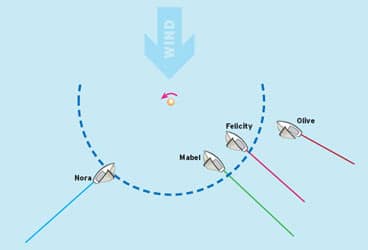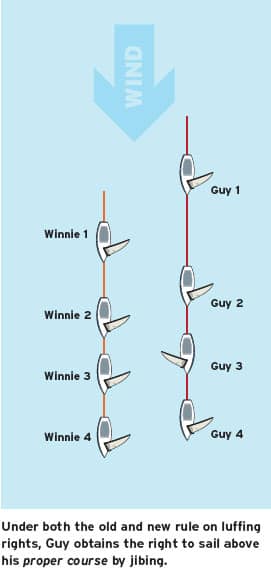
David Norton| |Under the new definition Fetching, Olive and Felicity are fetching the mark, Mabel may be fetching, and Nora clearly is not.| The focus of this year’s revision of the rules for marks and obstructions was on problems that old Rule 18 created for boats passing marks and obstructions. There were, however, a few other rule changes made as part of that “package” of changes. New Rule 20, the rule that permits a boat sailing closehauled to hail for room to tack to avoid an obstruction, is intended to produce the same “game” as old Rule 19, which it replaces. However, a few changes were made.
Rule 20 is primarily a safety rule to help boats sailing closehauled avoid collisions with obstructions. The rule’s role in promoting safety has been enhanced because new Rules 20.1 and 20.3 imply that, when a boat beating to windward hails for room to tack, she must be given that room even if safety does not require her to make a substantial course change to avoid the obstruction, or if the obstruction is a mark that she is fetching. If, after the hailed boat responds to the hail by giving room, she thinks that the hailing boat broke Rule 20.3, the hailed boat may protest. If the hailing boat acknowledges that she broke Rule 20.3, she may take a penalty as provided in Rule 44.1. If she does not, and a protest committee finds she broke Rule 20.3, she will be disqualified. It’s easy to comply with Rule 20 when a boat hails you for room to tack. On a beat to windward, whenever a boat to leeward or clear ahead of you hails for room to tack, give her that room and, if you think her hail was improper, protest her.
The sequence of steps that boats must take to comply with Rule 20 is now stated in new Rules 20.1(a), (b) and (c). Changes in wording were made to improve the organization and clarity of those rules. New Rule 20.2, Exoneration, replaces the statement “switching off” Rules 10 and 13 that was in old Rule 19.1. This change was made for several reasons: (1) consistency with the principle of, whenever possible, not switching off Section A or Section B rules; (2) consistency with the exoneration approach taken in new Rule 18.5; and (3) expanding exoneration to include other rules of Sections A and B that a boat might break while taking room she is entitled to under new Rule 20.1(b).
New Definition Fetching The word “fetching” is used in Rules 18.3 and 20.3. In past years, it has not been one of the terms defined in the Definitions section at the back of the rulebook. When a term is not defined there, its meaning is found in a dictionary and, if it is a nautical term, in specialized nautical dictionaries (see the Introduction to the rulebook). Dictionaries do not agree on the nautical meaning of the verb “to fetch.” Hence, the new definition was needed. It reads as follows: “A boat is fetching a mark when she is in a position to pass to windward of it and leave it on the required side without changing tack.”
The above diagram shows four boats nearing a windward mark to be left to port. Olive has overstood and Felicity is on a closehauled course that will allow her to leave the mark to port. Clearly, both are fetching the mark. Sometimes it will not be clear whether or not a boat is fetching a mark. If the wind, current, and waves permit, Mabel may be able to fetch the mark by luffing and using her momentum. However, if she has to turn past head to wind in order to leave the mark to port, then she is not fetching it. Even though Nora’s closehauled course will take her close to the mark, she is not fetching it because she must change tack to pass to windward of the mark and leave it on the required side-her port side.

David Norton| |****|
Change in Rule 17, the Rule that Limits Luffing Rights
The purpose of Rule 17 is to limit the luffing rights of a boat that establishes a leeward overlap from clear astern while close to the boat ahead. The first sentence of new Rule 17 (which, in the old rules, was numbered 17.1) has been changed by the addition of the words “on the same tack” so that it now reads as follows (the added words are underlined): If a boat clear astern becomes overlapped within two of her hull lengths to leeward of a boat on the same tack, she shall not sail above her proper course while they remain on the same tack and overlapped within that distance, unless in doing so she promptly sails astern of the other boat.
This change in Rule 17 was made necessary by a change in the definition Clear Astern and Clear Ahead; Overlap. In last year’s rules, the terms clear astern, clear ahead, and overlap did not apply to boats on opposite tacks unless old Rule 18, Rounding and Passing Marks and Obstructions, applied. This year, as I have explained in recent columns, that old rule has been replaced by two new rules, Rule 18, which applies at virtually all marks and Rule 19, which applies mainly at obstructions that are not marks. Under the new rules, the terms clear astern, clear ahead and overlap now apply to two boats on opposite tacks when either of two conditions is satisfied-when (1) Rule 18 applies or (2) “both boats are sailing more than ninety degrees from the true wind.” The second condition was added so that new Rule 19.2 will apply between boats passing an obstruction while they are running on opposite tacks, and so that boats on opposite tacks approaching a leeward mark while broad reaching or running would be overlapped before they reached the zone.
The added words in Rule 17 avoid two “game changes.” A situation in which those changes would have occurred is shown in the diagram at right. On a run, Guy overhauls Winnie and establishes an overlap to leeward and within two hull lengths of her. At position 2, Rule 17 prohibits Guy from sailing above his proper course. Between positions 2 and 4, Guy jibes from starboard to port tack and then jibes back onto starboard.
Under old Rule 17.1, if Guy had jibed onto port tack when he did, he would no longer have been subject to Rule 17 because he would no longer have been overlapped with Winnie, and when he jibed back onto starboard, Rule 17.1 would not have applied because the new overlap would not have been established by Guy overtaking from clear astern. Because of the change in the definitions of clear ahead, clear astern, and overlap, without the new underlined words, Rule 17 would continue to apply to Guy after his first and after his second jibe. With the added words, Guy’s first jibe switches off Rule 17. This is true because at position 3, he and Winnie, even though they are still overlapped and within two lengths of each other, are no longer on the same tack. Rule 17 is not switched on by Guy’s second jibe because the conditions for switching on the rule are not met.
Also, without the new underlined words, Rule 17 would have imposed an illogical requirement on Guy at position 3. At that point the boats are on opposite tacks, but, without the words “on the same tack,” Rule 17 would prohibit Guy from luffing above his proper course on port tack, even though such a luff would increase the separation between the boats.
E-mail for Dick Rose may be sent to rules@sailingworld.com.









